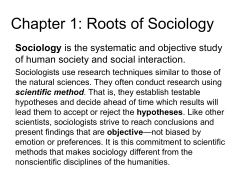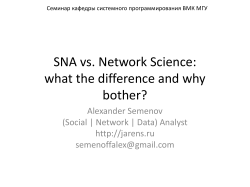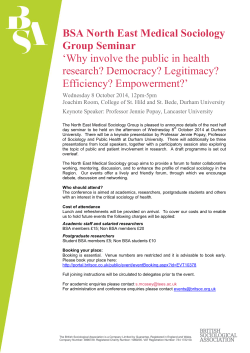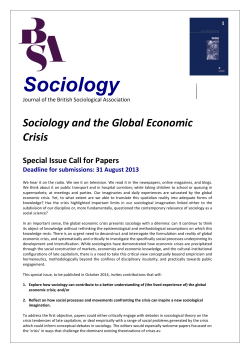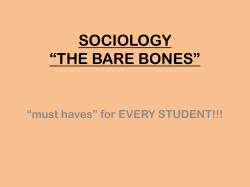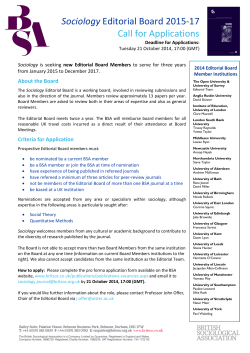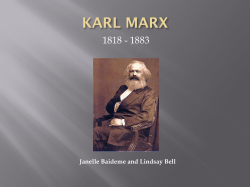
Chapter 1 What is sociology Sociology of human society and social interaction.
Chapter 1 What is sociology Sociology is the systematic and objective study of human society and social interaction. Sociologists use research techniques similar to those of the natural sciences. They often conduct research using scientific method. That is, they establish testable hypotheses and decide ahead of time which results will lead them to accept or reject the hypotheses. Like other scientists, sociologists strive to reach conclusions and present findings that are objective—not biased by emotion or preferences. It is this commitment to scientific methods that makes sociology different from the nonscientific disciplines of the humanities. The history and development of sociology • Henry de Saint-Simon(1760-1821) – He was the first scholar to treat society as a distinct and separate unit of analysis. He also was one of first to stress the idea that the social sciences might use the new methods of the natural sciences. But like most of the early social thinkers who followed the Industrial Revolution, Saint-Simon was interested in the analysis of society only as it related to his desire for social reform. August Comte(1798-1857) • He was considered the founder of sociology. He had once been personal secretary to SaintSimon. Comte coined the term sociology. Previously, he had called the discipline “positive philosophy”( social physics ), both to stress its scientific nature and to distinguish it from traditional philosophy. The aim of sociology, as he saw it, was to find the “invariable laws” of sociology upon which a new order could be based. Herbert Spencer • Spencer (1820-1903) put the idea that society is like an organism—a self-regulating system. Drawing an analogy to Charles Darwin’s theory of biological evolution, Spencer suggested that societies, like animal species, evolved from simple to more complex forms. Spencer was an early advocate of what later came to be called Social Darwinism—the view that the principle of survival of the fittest applies to societies and within societies. • Earthworm------->dog Karl Marx(1818-1883) • In contrast to Spencer’s view that societies are subjected to “natural” laws, Marx believed that societies follow historical laws determined by economic forces. He saw human history as a series of inevitable conflicts between economic classes. • Marx’s view on class conflict are reflected in the conflict school of modern sociology Primitive society slavery feudalism capitalism communism Productivity Economic base and superstructure Emile Durkheim(1858-1917) More than anyone, the French scholar Emile Durkheim defined the subject matter of sociology and pointed out how it differed from philosophy, economics, psychology, and social reform. In The Rules of Sociological Method (1894) and in Suicide (1897), Durkheim argued that the main concern of sociology should be what he called social facts. In contrast to those who reduce most social phenomena to individual psychological and biological traits, Durkheim felt that the main building blocks of societies are laws, customs, instititions, and organizations. Marx Weber(1864-1920) • Weber was perhaps the greatest single influence on modern sociology. He was particularly interested in the larger dimensions of society—its organizations and institutions—which he studied on a vast historical and worldwide scale. He is perhaps best known for his bureaucracy and capitalism. Much of Weber’s thought contrasts strongly with that of Marx. Weber argued that sociology should include the study of “social action”. George Simmel(1858-1918) • Unlike the other theorists we have discussed, who were interested in studying the larger structures of society, Gorege Simmel focused on smaller social units. He put forth the idea that society is best seen as a web of patterned interactions among people. He also believed the main purpose of sociology should be to examine the basic forms that that these interactions take. Some examples of the basic forms of interaction that Simmel analyzed are cooperation and conflict, leaders and followers, and the process of communication. Development of American Sociology • Chicago School – Sociology first became an established discipline in the Midwest. The sociologists at the University of Chicago during this period came to be known collectively as the “Chicago School”. They were interested in such typical American social problems as ghettos, immigration, race relations, and urbanization. They assembled a vast amount of useful statistical data and developed many important concepts that are still in use. Robert Park • The leading figure at the University of Chicago was Robert Park (1864-1944), who began teaching there in 1914. Park was a unique combination of news reporter, social activist, researcher, and pure theorist. He combined the perspectives of biology, conflict theory, and the sociology of Gorge Simmel into the first major introductory textbook in sociology. Many of his students later became influential sociologists at other American universities. Gorge Herbert Mead • Gorge Herbert Mead (1863-1931) was the major theorist of the symbolic interactionist branch of sociology that was born at the University of Chicago. Mead stressed that humans respond to abstract meanings as well as to concrete experience. Unlike most theorists of the time, Mead claimed that the human mind and self-consciousness are largely social creations. Thus he helped to define that aspect of sociology that sees individual behavior as the product of society. Sociological theories (1) • The functionalist perspective – It emphasizes the way in which each part of society contributes to the whole so as to maintain social stability. According to this perspective, society is like the human body or any other living organism. Like the parts of the body (such as the limbs, the heart, and the brain), the parts of society (such as families, businesses, and governments) function together in a systematic way that is usually good for the whole. Each part helps to maintain the state of balance that is needed for the system to operate smoothly. Sociological theories (2) • The conflict perspectives – It emphasizes conflict as a permanent aspect of societies and a major source of social change. This perspective is based on the assumption that the parts of society, far from being smoothly functioning units of a whole, actually are in conflict with one another. This is not to say that society in never orderly—conflict theorists do not deny that there is much order in the world—but rather that order is only one outcome of the ongoing conflict among society’s parts and that it is not always the natural state of things. – Conflict theorists trace their roots back to Marx and Simmel. They stress the dynamic, ever-changing nature of society. To them, society is always in a fragile balance. More often than not, social order (often quite temporary) stems from the domination of some parts of society over other parts rather than from the natural cooperation among those parts. Order is the product of force and constraint—domination—of the over the weak, the rich over the poor. Sociological theories (3) • The interactionist perspective – It focuses on how people interact in their everyday lives and how they make sense of their social interaction. Interactionists do not see society as such a controlling force, at least not to the degree that the macrosociologists do. Interactionists stress that people are always in the process of creating and changing their social worlds. Interactionists explore people’s motives, their purposes and goals, and the ways they perceive the world. Three perspectives—a summery Perspective Central concern Scope of theorizing Typical concepts Some proponents Fuctionalist How parts contribute to workings of total society or institutions Maro-level Manifest Durkeim functions, Parsons latent functions, Merton dysfunctions Conflict Social conflict and inequalities; why they arise and how they are maintained, Maro-level Class struggle, self-interests, domination of some social groups Marx Dahrendorf Collins interactionist Everyday encounters between people and the symbols by which they are interpreted microlevel Definition of the situation, Looking glass self Mead Cooley Goffman Chapter 2 culture and social structure • Culture refers to the social heritage of a people—those learned patterns for thinking, feeling, and acting that are transmitted from one generation to the next, including the embodiment of these patterns in material items. It includes both nonmaterial culture— abstract creations like values, beliefs, symbols, norms, customs, and institutional arrangements—and material culture—physical artifacts or objects like stone axes, computers, loincloths(缠腰带), tuxedos (晚礼服), automobiles, paintings, hammocks(吊床), and domed stadiums. • Society refers to a group of people who live within the same territory and share a common culture. Very simply, culture has to do with the customs of a people, and society with the people who are practicing the customs. Culture provides the fabric that enables human beings to interpret their experiences and guide their actions, whereas society represents the networks of social relations that arise among a people. Components of culture • Norms – Norms are social rules that specify appropriate and inappropriate behavior in given situations. They tell us what “should”, “ought”, and “must” do, as well as what we “should not”, “ought not” and “must not” do. In all cultures, the great body of rules deal with such matters as sex, property, and safty. Values values are broad ideas regarding what is desirable, correct, and good that most members of a society share. Values are so general and abstract that they do not explicitly specify which behaviors are acceptable and which are not. Instead, values provide us with criteria and conceptions by which we evaluate people, objects, and events as to their relative worth, merit, beauty, or morality. Components of culture • Symbols and language – Symbols are acts or objects that have come to be socially accepted as standing for something else. They come to represent other things through the shared understanding people have. – Language is a socially structured system of sound patterns (words and sentences) with specific and arbitrary meanings. Language is the cornerstone of every culture. Its is the chief vehicle by which people communicate ideas, information, attitudes, and emotions to one another. And its is the principal means by which human beings create culture and transmit it from generation to generation. Social structure (1) • Statuses – A status is a socially defined position in a group or society. Being female, black, a lawyer, or a rather is a status. There are two types of statuses. A status can be gained by a person’s direct effort, usually through competition, is called an achieved status(成就地 位). Most occupational positions in modern societies are achieved statuses. A social position to which a person is assigned according to standards that are beyond his or her control—usually parentage, age, and sex—is called ascribed status(先赋地位). Social structure (2) • Role – A role is the behavior expected of someone with a given status in a group or society. According to Ralph Linton (1936), one occupies a status, but plays a role. – There is sometimes a difference between the way a role is written in society’s script and the way people play that role. The role expectation(角色期待), society’s definition of the way a role ought to be played, does not always match role performance(角色表演), the way a person actually plays a role. – In the course of one day’s social interaction, a person must play many different roles. If opposing demands are made on a person by two or more roles, the situation is called role conflict(角色 冲突). Sometimes, opposing demands are built in into a single role; the personal stress caused by such opposing demands of a single role is called role strain (角色紧张Good, 1960). Social structure (3) • Group – Statuses and roles are building blocks for more comprehensive social structures, including groups. Sociologists view a group as two or more people who share a feeling of unity and who are bound together in relatively stable patterns of social interaction. – A group is more than a collection of people. Sociologists distinguish it from an aggregate(集合), which is simply a collection of anonymous individuals who are in one place at the same time. Shoppers in a mall, individuals waiting in line for football tickets, and audience at a concert, and a crowd watching a hockey game are examples of aggregates. – A group also differs from a category(类别), a collection of people who share a characteristic that is deemed to be of social significance. Common categories include age, race, sex, occupation, and educational attainment. Social Structures (4) • Institutions – Sociologists view institutions as the principal instruments whereby the essential tasks of living are organized, directed, and executed. Each institution is built about a standardized solution to a set of problems. The family institution has as its chief focus the reproduction, socialization, and maintenance of children; the economic institution, the production and distribution of goods and services; the political institution, the protection of citizens from one another and from foreign enemies; the religious institution, the enhancement of social solidarity and consensus; and the educational institution, the transmission of the cultural heritages from one generation to the next. Social structure (5) • Societies – A group of people who live within the same territory and share a common culture. By virtue of this common culture, the members of a society typically possess similar values and norms and a common language. Its members perpetuate themselves primarily though reproduction and comprise a more or less self-sufficient social unit. A society can be as small as a tribal community of several dozen people and as large as modern nations with millions of people. – Sociologists have classified societies in a good many ways. One popular approach is based on the principal way in which the members of a society derive their livelihood. Clearly, survival confronts all peoples with the problem of how they will provide for such vital needs as food, clothing , and shelter. • Hunting and gathering societies(狩猎采集社会) represent the earliest form of organized social life. Individuals survive by hunting animals and gathering edible foods. These societies are constantly on the move and small, consisting of about fifty or so members. Kinship is the foundation for most relationships. • Some ten thousand or so years ago, human beings learned how to cultivate a number of plants on which they depended for food. The digging stick, and later the hoe, provided the basis for horticultural societies(园耕社会). Horticulturalists clear the land by means of “slash and burn” technology, raise crops for two to three yeas, and then move on to new plots as the soil becomes exhausted. Their more efficient economies allow for the production of a social surplus—goods and services over and above those necessary for human survival. This surplus becomes the foundation for social stratification. – Five to six thousand yeas ago, in fertile river valleys such as those of the Middle East, the plow heralded an agricultural revolution and the emergence of agrarian societies. Innovations meant larger crops, more food, expanding populations, and even more complex forms of social organization. In time sophisticated political institutions emerged, with power concentrated in the hands of hereditary monarchs. – About 250 years ago, the Industrial Revolution gave birth to industrial societies whose productive and economic systems are based on machine technologies. The energy needed for work activities came in increasingly from hydroelectric plants, petroleum, and natural gas rather than from people and animals. Economic self-sufficiency and local market systems were displaced by complex divisions of labor, exchange relationships, and national and international market systems. – Some social analysts contend that the United States is currently moving in the direction of a postindustrial society (Bell, 1973). Other metaphors have been applied to the new and revolutionary patterns, including Alvin Toffler’s (1980) third wave (第三次浪潮)and John Naisbitt’s (1982) megatrends (大趋 势). Chapter 3 Socialization • In comparison with other species, we enter the world as amazingly “unfinished” beings. We are not born human, but become human only in the course of interaction with other people. Our humanness is a social product that arises in the course of socialization—a process of social interaction by which people acquire the knowledge, attitudes, values, and behaviors essential for effective participation in society. By virtue of socialization, a mere biological organism becomes transformed into a person— a genuine social being. The self • The formation of self is a central part of the socialization process. It is not a biological given, but emerges in the course of interaction with other people. The self represents the ideas we have regarding our attributes, capacities, and behavior. • Charles H. Cooley (1902) contended that our consciousness arises in a social context and coined the term looking-glass self—a process by which we imaginatively assume the stance of other people and view ourselves as we believe they see us. • George H. Mead (1863-1931) contended that we gain a sense of selfhood by acting toward ourselves in much the same fashion that we act toward others. In doing so, we “take the role of the other toward ourselves.” We mentally assume a dual perspective: We are simultaneously the subject doing the viewing and the object being viewed. In our imagination, we take the position of another person and look back on ourself from this standpoint. • Mead designates the subject aspect of the selfprocess the I and the object aspect of self the me. • According to Mead, children typically pass through three stages in developing a full sense of selfhood: – The play stage(玩耍阶段): children take the role of only one other person (significant other 重要他人)at a time and “try on” the person’s behavior. – The game stage(游戏阶段): children assume many roles. – The generalized other stage(类化他人阶段): children recognize that they are immersed within a larger community of people and that this community of people has very definite attitudes regarding what constitutes appropriate behavior. The social unit that gives individuals their unity of self is called the generalized other. Chapter 4 groups and organizations • The nature of social groups – A social group can be defined as two or more people who have a common identity and some feeling of unity, and who share certain goals and expectations about each other’s behavior. • People are bound by within two types of bonds: expressive ties and instrumental ties. Expressive ties (表现性关系)are social links formed when we emotionally invest ourselves to other people. Through association with people who are meaningful to us, we achieve a sense of security, love, acceptance, companionship, and personal worth. Instrumental ties (工具性关系)are social links formed when we cooperate with other people to achieve some goal. Primary group and secondary group • A primary group (初级群体) is a relatively small, multipurpose group in which the interaction is intimate and there is a strong sense of group identity. In primary group, people are bound by primary relationship—a personal, emotional, and not easily transferable relationship that includes a variety of roles and interests of each individual. • A secondary group (次级群体) is a specialized group designed to achieve practical goals; its members are linked mainly by secondary relationships. In contrast to a primary relationship, a secondary relationship is specialized, lacks emotional intensity, and involves only a limited aspect of one’s personality. Characteristics of primary and secondary relationships Primary relationship Secondary relationship 1.Includes a variety of roles and interests of each of the participants. It is general and diffuse in character. 1. Usually includes only one role and interest of each participant. It is specialized in character. 2. Involves the total personality of each 2. Involves only those aspects of the participant. personalities of the participants that are specifically relevant to the situation. 3. Involves communication that is free and extensive. 3. Limits communication to the specific subject of the relationship. 4. Is personal and emotion laden. 4. Is relatively impersonal and unemotional. 4. Is not easily transferable to another person. 5. Is transferable to others; that is , the participants are interchangeable. Other groups • An in-group (内群) is a group with which we identify and to which we belong. An out-group (外群) is a group with which we do not identify and to which we do not belong. • Reference groups (参考群体)—— social units we use for appraising and shaping attitudes, feelings, and actions. Groups dynamics • Group size – The smallest possible group, a dyad (二人组), is a group of two members. The bond formed by two people is unique: they can develop a sense of unity and intimacy not found in most larger groups. – According to Simmel, the triad (三人组), or group of three members, is in some ways the least stable of small groups. – As group gets larger, it grows dramatically more complex and formal. With each additional member there is a geometric increase in the number of possible social relationships within the group. • Leadership – Two types of leadership roles tend evolve in small groups (Bales, 1970). One, a task specialist, is devoted to appraising the problem at hand and organizing people’s activity to deal with it. The other, a socialemotional specialist, focuses on overcoming interpersonal problems in the group, defusing tensions, and promoting solidarity. The former type of leadership is instrumental, directed toward the achievement of group goals; the latter is expressive, oriented toward the creation of harmony and unity. • Classical experiments in leadership by Kurt Levin and his associates (1939) – In these pioneering investigations, adult leaders working with groups of 11-year-old boys followed one of three leadership styles. In the authoritarian (权威 的) style, the leader determined the group’s policies, gave step-by-step directions so that the boys were certain about their future tasks, assigned work partners, provided subjective praise and criticism, and remained aloof from group participation. In contrast, in the democratic (民主的) style, the leader allowed the boys to participate in decision-making processes, outlined only general goals, suggested alternative procedures, permitted the members to work with whomever they wished, evaluated the boys objectively, and participated in group activities. Finally, in the laissez-fair (放任的)style, the leader adopted a passive, uninvolved stance; provided materials, suggestions, and refrained from commenting on the boy’s work. – The researchers found that authoritarian leadership produces high level of frustration and hostile feelings toward the leader. Productivity remains high so long as the leader is present, but it slackens appreciably in the leader’s absence. – Under democratic leadership members are happier, feel more group-minded and friendlier, display independence, and exhibit low levels of interpersonal aggression. – Laissez-faire leadership resulted in low group productivity and high levels of interpersonal aggression. • Group think – A decision-making process found in highly cohesive groups in which the members become so preoccupied with maintaining consensus that their critical faculties are impaired. • Conformity – Groupthink research testifies to the powerful social pressures that operate in group settings and produce conformity. Although such pressures influence our behavior, we often are unaware of them. In a pioneering study, Muzafer Sherif (1936) demonstrated this point with an optical illusion. Formal organizations • A group people deliberately form for the achievement of specific objectives. • Types of formal organizations – Amitai Etzioni (1964) classifies organizations into three types: voluntary, coercive, and utilitarian. Voluntary organizations are associations that members enter and leave freely. People also become members of some organizations—coercive organizations—against their will. They may be committed to a mental hospital, sentenced to prison, or drafted into the armed forces. Individuals also enter formal organizations formed for practical reasons—utilitarian organizations. Universities, corporations, farm organizations and government bureaus and agencies are among the organizations people form to accomplish vital everyday tasks. Bureaucracy • A social structure made up of a hierarchy of statuses and roles that is prescribed by explicit rules and procedures and based on a division of function and authority. • Weber’s analysis of bureaucracy – 1. Each office or position has clearly defined duties and responsibilities. In this manner, the regular activities of the organization are arranged within a clear-cut division of labor. – 2. All offices are organized in a hierarchy of authority that takes the shape of a pyramid. Officials are held accountable to their superiors for subordinates’ actions and decisions in addition to their own. • 3. All activities are governed by a consistent system of abstract rules and regulations. • 4. All offices carry with them qualifications and are filled on the basis of technical competence, not personal considerations. • 5. Incumbent do not “own” their offices. Positions remain the property of the organization, and officeholders are supplied with the items they require to perform their work. • 6. Employment by the organization is defined as a career. Promotion is based on seniority or merit, or both. • 7. Administrative decisions, rules, procedures, and activities are recorded in written documents preserved in permanent files. Disadvantages of bureaucracy • Trained Incapacity (练就的无能) – Social critic Thorstein Veblen (1921) pointed out that bureaucracies encourage their members to repy on established ruled and regulations and to apply them in an unimaginative and mechanical fashion—a pattern he called trained incapacity. As a result of the socialization provided by organizations, individuals often develop a tunnel vision that limits their ability to respond in new ways when situations change. • Parkinson’s Law – Northcoe Parkinson (1962) contends that bureaucracy expands not because of an increasing workload, but because officials seek to have additional subordinates hired in order to multiply the number of people under them in the hierarchy. These subordinates in turn create work for one another, while the coordination of their work required still more officials. • Oligarchy (寡头政治) – Robert Michels (1911/1966), a sociologist and friend of Weber, argued that bureaucracies contain a fundamental flaw that makes them undemocratic social arrangements: They invariably lead to oligarchy—the concentration of power in the hands of a few individuals, who use their offices to advance their own fortunes and self-interests. He called this tendency the iron law of oligarchy(寡头政 治铁律).
© Copyright 2025
